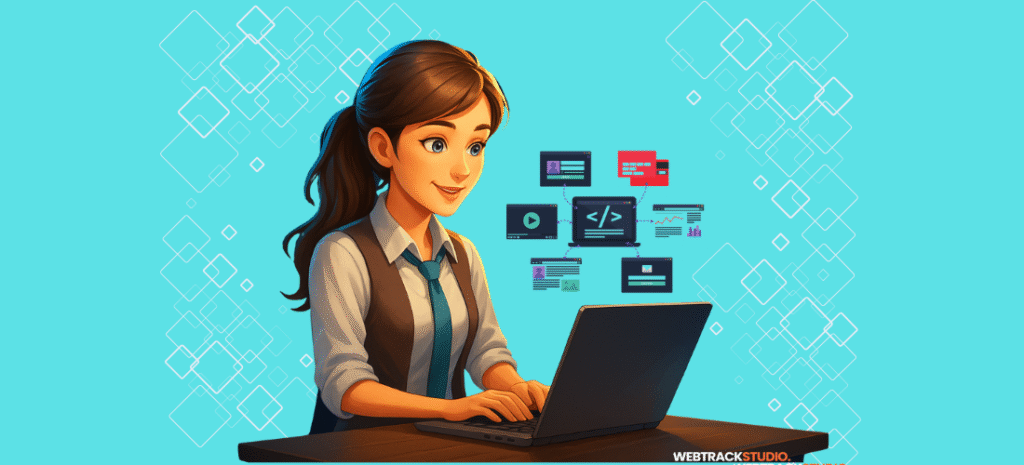The Bottom Line: Generic website templates make your business look ordinary. Custom development creates unique experiences that convert visitors into customers.
Key Stats:
- 75% of users judge company credibility based on website design
- Custom sites see 15-40% higher conversion rates than templates
- 88% of online shoppers won’t return after a bad user experience
Best For: Growing businesses ready to invest $5K-$50K for competitive advantages.

The Hidden Cost of Using Website Templates
Picture this: A customer searches for accounting software. They visit three websites. All three use the same template with minor color changes. Same layout. Same features. Same generic stock photos.
Which one do they choose? Usually the cheapest, because nothing else differentiates them.
Now imagine the fourth website. Clean design that reflects their brand. A calculator tool that shows potential savings. Testimonials from companies in the visitor’s industry. A demo that adapts based on company size.
That business wins the sale, often at a higher price point.
The Cost of Templates:
- You look like everyone else in your industry
- Limited functionality (what the template offers, nothing more)
- Slow loading from unnecessary code
- Poor mobile experience on many templates
- Difficult to scale as you grow
What is Custom Development?
Let me be specific. Custom development means:
You Choose Everything:
- Exact features your business needs (not what a template includes)
- Brand colors, fonts, and design elements throughout
- How users navigate and interact with your site
- What happens when someone clicks, scrolls, or submits a form
The Difference:
Template Approach: Standard product grid, basic search, generic checkout process
Custom Approach: Smart product recommendations based on browsing, quick-view popups, one-click checkout for returning customers, tools specific to your products
7 Trends for Custom Websites
1. Smart Personalization
What It Looks Like:
- First-time visitor sees “New here? Take our 2-minute quiz”
- Returning visitor sees “Welcome back! Your saved items are ready”
- Location-based content (prices in local currency, nearby store locations)
Personalized experiences can increase revenue by 35% or more.
2. Headless CMS
The Problem: You update your product description. Now you need to copy it to your mobile app, email newsletter, and voice assistant. Four places, four updates.
The Solution: Update once, appears everywhere automatically.
Who Needs This: Businesses managing content across multiple platforms (website, app, kiosks, voice devices).
3. Micro-Animations
Bad Animation: Flashy effects that distract and slow down your site.
Good Animation:
- Button slightly enlarges when hovered (shows it’s clickable)
- Progress bar during checkout (reduces abandonment)
- Smooth transitions between pages (feels professional)
Result: These subtle cues increase completed actions by 20-30%.
4. Accessibility
What This Includes:
- Text people can actually read (proper contrast, scalable fonts)
- Keyboard navigation (not everyone uses a mouse)
- Screen reader compatibility (for visually impaired users)
- Video captions
Business Case: Poor accessibility can lead to lawsuits and lost customers. Beyond legal risk, accessible sites convert better for ALL users.
5. Voice Search Ready
The Shift:
- Typed search: “plumber near me”
- Voice search: “OK Google, find a plumber open now within 5 miles”
What Your Site Needs:
- FAQ pages answering natural questions
- Local business information clearly marked
- Fast loading (voice assistants prioritize speed)
Impact: 50% of searches will be voice-based by 2026. Are you showing up?
6. Clean, Fast, Focused Design
Template Site: Cluttered homepage with 12 different calls-to-action, slow loading, users confused about what to do next.
Custom Site: Clear value proposition, one primary action per page, loads in under 2 seconds.
Result: Bounce rate drops significantly. Time on site increases substantially.
7. Personalized User Dashboards
For SaaS Companies:
- Usage analytics showing value
- Recommended features based on their plan
- One-click access to common tasks
For E-commerce:
- Order tracking front and center
- Reorder favorite items quickly
- Personalized deals based on purchase history
Result: Customers who use dashboards have significantly higher retention rates.
Template vs Custom
| Factor | Template Site | Custom Development |
|---|---|---|
| Initial Cost | $500-$3,000 | $10,000-$50,000+ |
| Launch Time | 2-4 weeks | 8-16 weeks |
| Unique Features | Limited to template | Unlimited |
| Looks Like Competitors | Yes | No |
| Mobile Experience | Often poor | Optimized |
| Load Speed | Slow (bloated code) | Fast (optimized) |
| Scalability | Limited | Built to grow |
| SEO Capability | Basic | Advanced |
| Conversion Rate | 1-2% average | 3-5% average |
| Long-term Cost | High (plugins, redesigns) | Lower (built right) |
Frequently Asked Questions
Do this math: If your current site converts at 2% and custom could get you to 3.5%, calculate the extra revenue. If it exceeds development costs within 12 months, yes.
Example: 5,000 monthly visitors × 1.5% extra conversion × $100 average sale = $7,500 extra monthly = $90,000 annually. A $30,000 investment pays back in 4 months.
Most businesses see improved metrics within the first month after launch. Full ROI typically takes 6-12 months depending on your traffic and industry.
You can, but it often costs more total. Starting custom builds the right foundation. Migrating from templates means rebuilding from scratch (you cannot just “upgrade” a template to custom).
That’s the point of custom. The system is built to adapt. Adding features costs significantly less than with templates (which often require complete redesigns).
No. We build user-friendly admin panels. If you can use email, you can update your site. Plus you get training and ongoing support.
Custom sites need less maintenance than template sites. No plugin conflicts, no theme updates breaking things. We typically recommend quarterly check-ins for optimization.
Look for:
- Client references you can actually contact
- Portfolio of diverse custom projects (not just template customizations)
- Clear process from discovery to launch
- Transparent pricing
- Ongoing support options
Come prepared with:
- Realistic budget and timeline
- Your business goals (specific numbers)
- Problems with your current site
- Competitor sites you admire (and why)
- Features you must have vs nice to have
Is Custom Development Right for You?
Custom development makes sense when:
- The math shows clear ROI within 18 months
- Your current site actively limits growth
- User experience significantly impacts your sales
- You need competitive differentiation
It does NOT make sense when:
- You are just starting and testing your concept
- Budget constraints make ROI impossible
- Your industry barely uses digital channels
- You compete entirely on factors other than experience
The Question to Ask: Will this investment generate more value than it costs within a reasonable timeframe?
If yes, waiting only delays that value creation.
What to Do Next
Step 1: Audit Your Current Situation
- What is your current website conversion rate?
- Where do users drop off in your funnel?
- What features do you wish you had?
- How much revenue does your site generate monthly?
Step 2: Calculate Potential ROI
Use this formula: (Monthly Visitors × Improved Conversion % × Average Sale Value × 12 months) – Development Cost = Annual Net Benefit
Step 3: Define Your Must-Haves
List of features in priority order:
- Critical for business operations
- Significantly improve user experience
- Nice to have but not essential
Step 4: Set Your Budget Range
Based on your ROI calculation, determine what investment makes sense.
Remember: if the math shows positive ROI in under 18 months, it is typically worth pursuing.
Step 5: Research Development Partners
Request proposals from 3-5 developers. Compare:
- Understanding of your business goals
- Proposed solutions (not just what you asked for)
- Timeline and milestones
- Total cost (including post-launch support)
- Portfolio relevance
Step 6: Start with Discovery
Many developers offer paid discovery phases ($2,000-$5,000) before full development. This produces:
- Detailed project scope
- Wireframes and site map
- Technical requirements
- Accurate timeline and budget
This investment protects you from scope creep and ensures alignment before significant spending.
Ready to Explore Custom Development?
We specialize in building websites that deliver measurable business results, not just attractive designs.
What happens when you contact us:
- Free 30-minute consultation – We review your current site, goals, and challenges
- No-obligation proposal – If we’re a fit, you get detailed scope and pricing
- Optional discovery phase – Deep dive into requirements before full commitment
- Transparent development – Regular updates, testing opportunities, clear milestones
- Launch and beyond – Training, support, and optimization
Contact us: in**@************io.com
Include in your email:
- Your website URL (if you have one)
- Brief description of your business
- Main goals for a new website
- Approximate budget range
- Ideal timeline
We respond to all inquiries within one business day.
One Final Thought: Your website is not an expense. It is a revenue-generating asset. The question is whether it is generating as much as it could.


